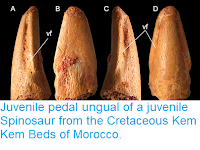During the Late Jurassic high sea levels reduced Europe to a series of island land masses, with variable faunal affinities to both East Asia and North America. The Iberian Massif comprising Portugal and western Spain is one of the few European landmasses of the time to preserve terrestrial faunas in situ (most fossils of Late Jurassic land animals from Europe are known form shallow marine deposits) including numerous Dinosaur trackways. The Vega, Tereñes and Lastres formations of the Asturias Region of northern Spain has produced numerous Dinosaur trackways, as well as the remains of Stegosaurs, Ornithopods, Sauropods and Theropods, though these are fragmentary and consist largely of isolated bones and teeth. Theropods are known from very little material, including a few isolated teeth and a caudal (tail) vertebra, which has not previously been discovered in any detail.
In a paper published in the journal PeerJ on 5 July 2018, Oliver Rauhut of the Bayerische Staatssammlung für Paläontologie und Geologie, and the GeoBioCenter, and Department for Earth and Environmental Sciences at Ludwig-Maximilians-University, Laura Piñuela of the Museo del Jurásico de Asturias, Diego Castanera, also of the Bayerische Staatssammlung für Paläontologie und Geologie, and the
GeoBioCenter at
Ludwig-Maximilians-University, and José-Carlos García-Ramos and Irene Sánchez Cela, also of the Museo del Jurásico de Asturias, formally describe the Asturian
The vertebra is referred to by the specimen number MUJA-1913; it is an anterior caudal vertebra (tail vertebra from close to the body) from a calcareous conglomerate within the Vega Formation. Most of the centrum is preserved, as is the base of the neural arch (dorsal section of the vertebra, including the channel through which the spinal cord runs), but none of the processes upon the neural arch. The forward surface of the centrum has been heavily eroded, but the posterior surface is well preserved, being concave and 140-145 mm in diameter. The centrum is about 150 mm high and 90 mm deep, with an anterior (forward) surface offset from the posterior surface. The neural canal is about 35 mm wide.
Anterior caudal vertebra of a giant megalosaurid from the Vega Formation, MUJA-1913. (A) Left lateral view. (B) Posterior view. (C) Ventral view. (D) Dorsal view. Study sites: ch, chevron facet; d, depression on anterior end of dorsal surface of transverse process; l, lamina dividing the conical postzygocentrodiapophyseal fossa from a shallow dorsal depression; pcd, pleurocentral depression; pcdf, postzygocentrodiapophyseal fossa; pcdl, posterior centrodiapophyseal lamina; vg, ventral groove. Scale bar is 50 mm. Oliver Rauhut and Diego Castanaera in Rauhut et al. (2018).
The size of MUJA-1913 is exceptional, at 150 mm in height it is 15% larger than the anterior caudal vertebrae of Torvosaurus, the largest known Therapod from the Late Jurassic of the Iberian Massif, and the largest recorded Theropod from Europe to date, and 10% larger than the same bone of Spinosaurus aegyptiacus, possibly the largest Theropod Dinosaur ever. The only comparably large caudal vertebrae come from the largest Cretaceous Carcharodontosaurids and Tyranosaurids, and possibly the largest Late Jurassic Allosaurids of North America. The structure of MUJA-1913 is consistent with that of a large Megalosaurid (the group which includes Torvosaurus), probably around 10 m in length.
The tip of a large Theropod Dinosaur was round at the same level within the formation. This is flattened with evenly spaced carinae (ridges on the cutting edge), and an anastomosing (vein-like) ornamentation, consistent with having come from a Megalosaur.
Tip of a large Megalosaurid tooth fromthe Vega Formation. (A) General view in lingual or labial view. (B) Detail of distal serrations and anastomosing enamel ornamentation. Scale bars are 10 mm. Oliver Rauhut and Diego Castanaera in Rauhut et al. (2018).
Rahaut et al. also report a series of new footprints and trackways from the Lastres Formation (which overlies and is slightly younger than the Vega Formation), all of which belong to Therapod Dinosaurs and are greater than 53 cm in length, with the largest being 82 cm in length and 66 mm in width. These fall into two broad groups anatomically, and are suggested to be evidence of the presence both large Megalosaurids and Allosaurids.
Giant Asturian Jurassic footprints, strongly mesaxonic (Morphotype B). (A) MUJA-1263. (B) MUJA-0213, scale bar: 1 m. (C) Specimen still on Argu¨ero sea cliffs. (D–F) Same specimens, photographs with outline drawings to better illustrate track morphology. José-Carlos García-Ramos in Rauhut et al. (2018).
See also...
Follow
Sciency Thoughts on Facebook.









